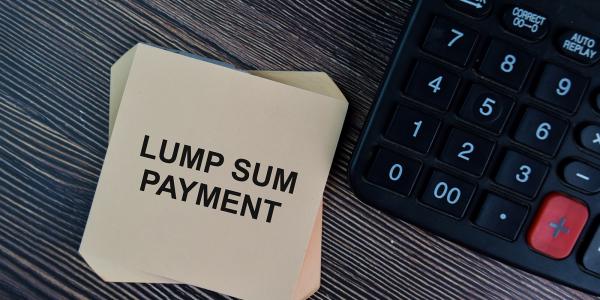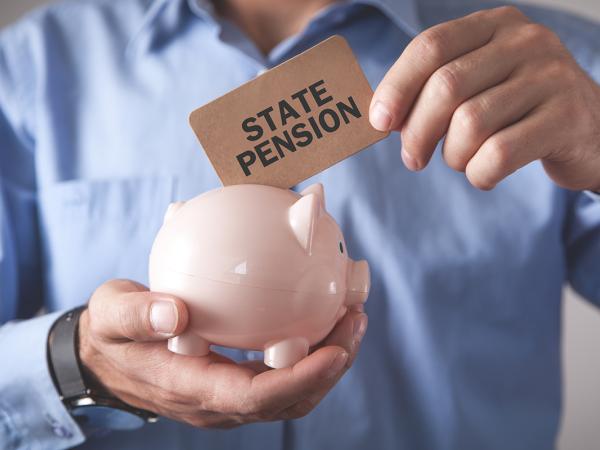Tax on deferred state pension lump sums
This page explains what tax is applied to a state pension lump sum, which you might receive if you reached state pension before 6 April 2016 but chose to defer (put off) receiving your state pension until a later date.

Content on this page:
Introduction
If you reached state pension age before 6 April 2016 and deferred receiving your state pension for at least 12 months in a row, you can choose to receive a one-off lump sum – in addition to your regular state pension – when you later decide to draw your state pension. This is taxed as income, but in a special way, unlike other pension income.
Alternatively, you may receive a state pension lump sum because your spouse or civil partner chose to defer their state pension but died before any lump sum was paid.
If you reached state pension age on or after 6 April 2016, you may still defer receiving your state pension, but you will not be entitled to receive a lump sum.
If you are simply backdating your claim for state pension, this this is not covered by the special rules that follow. You can read more about tax on backdated claims on our page Tax on the state pension.
Tax on the lump sum
The rate of tax that will be used on your state pension lump sum is generally the highest marginal rate that applies to your other income for the applicable tax year. See the heading below: Tax year in which the lump sum is taxed.
This is intended to avoid the lump sum (or part of it) being taxed at a higher rate than you would have paid had you not deferred it. However, the rules may not necessarily give that result.
While this can mean you can pay no tax at all on such a lump sum (if all of your taxable income falls within your personal allowance, for example), it is important to bear in mind that when you are looking at your ‘other income’ you must include any regular state pension that will come into payment once deferral stops.
Complexities
When thinking about the tax rate payable on a lump sum, you must ignore the 0% rates which are used to tax savings and dividend income – that is the starting rate for savings, the savings nil rate (or personal savings allowance) and the dividend nil rate (or dividend allowance).
In other words, the question is what is the highest rate of tax which would apply if income falling in these 0% rates were taxed at the normal rates. This can make a significant difference to the tax payable on the lump sum.
For example, if your total taxable income falls within the basic rate band (even if some of that income is taxed at 0% due to it being taxed at the savings and dividend rates), you will pay tax at 20% on your state pension lump sum.
For the purpose of working out the tax on a state pension lump sum, because we are looking at the tax rate applicable, we also ignore any allowances and reliefs which are in fact ‘tax reducers’ in the tax calculation, such as the marriage allowance.
Word of warning: marriage allowance
You need to understand how the marriage allowance, or transferable tax allowance, works so that you can understand how it affects the tax on state pension lump sums.
The member of the couple that gives up 10% of their personal allowance to their partner has a reduced personal allowance. But the partner receiving the allowance does not get a higher personal allowance, they instead get a tax credit.
If you are a Scottish taxpayer, different income tax rates and bands apply to your non-savings and non-dividend income. State pension lump sums count as non-savings and non-dividend income and are liable to income tax according to the Scottish rates and bands. There is more information in our section on Scottish income tax.
From 6 April 2019, a Welsh income tax also applies, however for 2024/25 there is no practical effect on the amount of tax Welsh taxpayers have to pay.
Practicalities
Unlike with other payments of state pension, The Pension Service deducts tax from the lump sum on making the payment, having taken account of information that you provide about your rate of tax as part of the claim process. As the calculation is made during the tax year, it will not always be correct. If the wrong tax rate is used an overpayment of tax may arise or you may have to pay more tax to make up the difference. HM Revenue & Customs (HMRC) will make the adjustment after the year end.
If you live in Scotland and are a Scottish taxpayer, The Pension Service deducts tax at either 20% or 40% (UK rates), rather than the Scottish rate at which you are liable. If the correct rate should be anything other than the Scottish basic rate (20%), then the deduction will be incorrect. You will either have an underpayment or an overpayment of tax. Normally HMRC will work out the correct tax position after the end of the tax year, and they will send you a repayment or ask you to pay any additional tax that you owe. If you are a Scottish taxpayer, it is particularly important therefore that you check what tax has been deducted and how much you should have paid.
Tax year in which the lump sum is taxed
The state pension lump sum is usually taxed in the year in which you stop deferring and decide to claim it (specifically it is taxed at the point at which the first benefit payment date falls). This will usually be the same tax year in which you notify the DWP’s Pension Service of your claim to the state pension. However, if you claim very close to the tax year end, it could be the next tax year.
Delaying receipt of the lump sum
In the year in which you retire or finally stop work it might be that your tax rate will be higher, because of your employment income being included in the calculation, than it would be in the following year when you may have a reduced income.
As such, you can choose to delay payment of the lump sum to the next tax year to the one in which you stop deferring, which means that it will then be taxed in that later year when your tax rate is lower. You might choose to do that if, for example, you are a basic rate (20%) taxpayer in the year you stop deferring but will be a non-taxpayer the following year.
If you are thinking of taking a pension lump sum under either the flexible pensions or trivial commutation rules, you need to co-ordinate when this is taken with any state pension deferral planning, as those types of pension lump sums are taxable as ordinary income and might push you into a higher tax rate.
Note: if you wish to delay receiving a state pension lump sum to the start of the next tax year, you need to tell the Pension Service when you claim the lump sum, or within a month of the date you make the claim.
Dying before receiving your state pension lump sum
If you die before you claim your pre-2016 deferred state pension, and are married or in a civil partnership, the lump sum will be paid to your surviving spouse or civil partner and taxed in the manner discussed in ‘Tax on a deceased spouse’s (or civil partner’s) state pension lump sum’ below.
If you were not married or in a civil partnership but you had claimed the lump sum before you died, it will be paid to your estate.
If you had not claimed it before you died, any accrued lump sum is lost and only three months of State Pension can be claimed by your personal representatives.
Tax on a deceased spouse’s (or civil partner’s) state pension lump sum
The tax is calculated in accordance with the rules set out above and is payable by you for the tax year when the lump sum payment is due to be paid. The due date for payment of that lump sum depends on whether you are already receiving your state pension when your spouse or civil partner dies.
If you are already receiving your state pension, the lump sum becomes payable and is taxable on the date of your spouse’s or civil partner’s death. On the other hand, if you are not yet receiving a state pension at that time, the lump sum becomes payable and taxable at the time you become entitled to your state pension.
Interaction with capital gains tax
The deferred state pension lump sum is not included in your total income when calculating your tax. As described above, you work out the highest main tax rate that applies to your other income and then that is used to tax the lump sum.
This means that in turn, your basic rate band is not ‘used up’ by the lump sum and is therefore available to use when working out any capital gains tax for the year. Likewise, the capital gain will not affect the rate of tax on the lump sum, as the legislation states that the rate of tax applied to the lump sum is calculated by reference to the income tax calculation, and the highest tax rate applied to your other income for the year.
Further information
For more information on deferring the state pension, see Putting off (deferring) claiming the state pension.
The DWP has published a guide on deferring your state pension, which includes information on state pension lump sums and what happens if you die. You can find this guide on GOV.UK.
We have had reports from individuals that they have been given incorrect information by DWP/The Pension Service and HMRC helplines on how pre-6 April 2016 state pension lump sums are taxed. You might find it useful to note the following:
- The law on which the above guidance is based is found in Finance (No 2) Act 2005, sections 7 to 10;
- HMRC’s official guidance for their staff on this tax treatment is in the Employment Income Manual at EIM75750.
If you have been misinformed by HMRC, you could consider making a complaint. Information about how to complain to DWP/The Pension Service can be found on GOV.UK.



